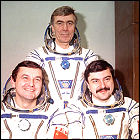 The Soyuz TM-4 mission is launched by the Soviet Union, en route to space station Mir. Cosmonauts Vladimir Titov and Musa Manarov take up residence as the new long-duration crew aboard Mir, formally known as Expedition 3, and they eventually break all previous space endurance records by staying aboard Mir for exactly one year and one day, returning to Earth on December 21st, 1988. Cosmonaut Anatoli Levchenko, after the week-long overlap with the Expedition 2 crew, returns to Earth with Expedition 2 crew members Yuri Romanenko and Aleksandr Aleksandrov aboard the Soyuz TM-3 vehicle.
The Soyuz TM-4 mission is launched by the Soviet Union, en route to space station Mir. Cosmonauts Vladimir Titov and Musa Manarov take up residence as the new long-duration crew aboard Mir, formally known as Expedition 3, and they eventually break all previous space endurance records by staying aboard Mir for exactly one year and one day, returning to Earth on December 21st, 1988. Cosmonaut Anatoli Levchenko, after the week-long overlap with the Expedition 2 crew, returns to Earth with Expedition 2 crew members Yuri Romanenko and Aleksandr Aleksandrov aboard the Soyuz TM-3 vehicle.

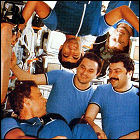 Cosmonauts Anatoly Solovyev, Viktor Savinykh and Aleksandr Aleksandrov lift off for a week-long visit to Soviet space station Mir aboard Soyuz TM-5. Numerous biological and astronomical experiments are conducted by the blended crew, and at the end of the week of joint activities, the Soyuz TM-5 crew use the older TM-4 capsule to return home, leaving the station crew with a newer vehicle.
Cosmonauts Anatoly Solovyev, Viktor Savinykh and Aleksandr Aleksandrov lift off for a week-long visit to Soviet space station Mir aboard Soyuz TM-5. Numerous biological and astronomical experiments are conducted by the blended crew, and at the end of the week of joint activities, the Soyuz TM-5 crew use the older TM-4 capsule to return home, leaving the station crew with a newer vehicle.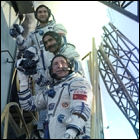 The Soviet Union launches the Soyuz TM-6 mission to the Mir space station, with cosmonauts Vladimir Lyakhov, Valeri Polyakov and Abdul Ahad Mohmand aboard. Lyakhov and Mohmand remain aboard Mir for only a week, participating in experiments involving both crews, but Polyakov, a medical doctor, remains on Mir to monitor the Expedition 3 crew in the final months of their unprecedented one-year stay in orbit. This crew exchanges spacecraft with the station crew, returning home in the Soyuz TM-5 vehicle after a week on Mir, but their return is plagued by problems both technical and otherwise.
The Soviet Union launches the Soyuz TM-6 mission to the Mir space station, with cosmonauts Vladimir Lyakhov, Valeri Polyakov and Abdul Ahad Mohmand aboard. Lyakhov and Mohmand remain aboard Mir for only a week, participating in experiments involving both crews, but Polyakov, a medical doctor, remains on Mir to monitor the Expedition 3 crew in the final months of their unprecedented one-year stay in orbit. This crew exchanges spacecraft with the station crew, returning home in the Soyuz TM-5 vehicle after a week on Mir, but their return is plagued by problems both technical and otherwise.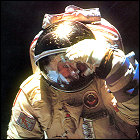 The Soviet Union launches Soyuz TM-7 to space station Mir, ferrying cosmonauts Alexander Volkov and Sergei Krikalev, and French spationaut Jean-Loup Chrétien to the station. Volkov and Krikalev will remain aboard Mir for 151 days, while Chrétien will remain for a shorter 24-day mission. Chrétien had visited the Salyut 7 space station on his previous spaceflight; his next flight, in 1997, will visit Mir again, this time by way of Space Shuttle Atlantis. Unusually, the return of this Mir crew will leave the station unoccupied for almost half a year.
The Soviet Union launches Soyuz TM-7 to space station Mir, ferrying cosmonauts Alexander Volkov and Sergei Krikalev, and French spationaut Jean-Loup Chrétien to the station. Volkov and Krikalev will remain aboard Mir for 151 days, while Chrétien will remain for a shorter 24-day mission. Chrétien had visited the Salyut 7 space station on his previous spaceflight; his next flight, in 1997, will visit Mir again, this time by way of Space Shuttle Atlantis. Unusually, the return of this Mir crew will leave the station unoccupied for almost half a year. Cosmonauts Alexander Viktorenko and Aleksandr Serebrov lift off aboard the Soviet spacecraft Soyuz TM-8, bound for the presently unoccupied space station Mir (which had been left without a crew since April 1989). At a distance of only 4 meters to Mir’s docking hatch, Soyuz TM-8 suffers a breakdown of its automated docking system, and Viktorenko has no choice but to back the Soyuz away and carefully dock under manual control. The two-man crew remains aboard Mir for 166 days, returning to Earth in February 1990.
Cosmonauts Alexander Viktorenko and Aleksandr Serebrov lift off aboard the Soviet spacecraft Soyuz TM-8, bound for the presently unoccupied space station Mir (which had been left without a crew since April 1989). At a distance of only 4 meters to Mir’s docking hatch, Soyuz TM-8 suffers a breakdown of its automated docking system, and Viktorenko has no choice but to back the Soyuz away and carefully dock under manual control. The two-man crew remains aboard Mir for 166 days, returning to Earth in February 1990.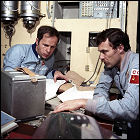 Cosmonauts Anatoly Solovyev and Aleksandr Balandin lift off from the Soviet Union aboard Soyuz TM-9, on their way to a stay aboard the Mir space station. Upon arriving at the station, an inspection of their spacecraft reveals that some of the Soyuz’ thermal blankets detached themselves during launch, though ground controllers decide against such drastic measures as cutting the mission short or launching Soyuz TM-10 early as a rescue mission. Solovyev and Balandin remain aboard Mir for 179 days, greeting the station’s next crew in August and returning to Earth without incident.
Cosmonauts Anatoly Solovyev and Aleksandr Balandin lift off from the Soviet Union aboard Soyuz TM-9, on their way to a stay aboard the Mir space station. Upon arriving at the station, an inspection of their spacecraft reveals that some of the Soyuz’ thermal blankets detached themselves during launch, though ground controllers decide against such drastic measures as cutting the mission short or launching Soyuz TM-10 early as a rescue mission. Solovyev and Balandin remain aboard Mir for 179 days, greeting the station’s next crew in August and returning to Earth without incident.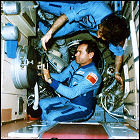 The Soviet Union launches Soyuz TM-10, carrying cosmonauts Gennadi Manakov and Gennady Strekalov to space station Mir for a long-duration stay in orbit. After a 130-day stay aboard Mir, the TM-10 crew returns, bringing with them Japanese TV reporter Toyohiro Akiyama, who would arrive aboard Mir via Soyuz TM-11 in December. Strekalov will return to serve another tour aboard Mir in the 1990s, becoming the first Russian cosmonaut to arrive in a Soyuz and return home in an American space shuttle.
The Soviet Union launches Soyuz TM-10, carrying cosmonauts Gennadi Manakov and Gennady Strekalov to space station Mir for a long-duration stay in orbit. After a 130-day stay aboard Mir, the TM-10 crew returns, bringing with them Japanese TV reporter Toyohiro Akiyama, who would arrive aboard Mir via Soyuz TM-11 in December. Strekalov will return to serve another tour aboard Mir in the 1990s, becoming the first Russian cosmonaut to arrive in a Soyuz and return home in an American space shuttle.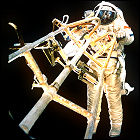 Soyuz TM-11 lifts off from the Baikonur Cosmodrome in the Soviet Union, bound for the space station Mir. Aboard the Soyuz is a crew of three: cosmonauts Viktor Afanasyev and Musa Manarov, with Tokyo Broadcasting System reporter Toyohiro Akiyama, who transmits live reports from Mir for the duration of his week in orbit. (Akiyama will return to Earth with the Soyuz TM-10 crew.) Akiyama is the first space traveler whose seat has been commercially bought and paid for, a flight which ignites the “space tourism” industry built around buying Soyuz seats. Afanasyev and Manarov remain in orbit for 175 days, returning to Earth with British space traveler Helen Sharman in May 1991.
Soyuz TM-11 lifts off from the Baikonur Cosmodrome in the Soviet Union, bound for the space station Mir. Aboard the Soyuz is a crew of three: cosmonauts Viktor Afanasyev and Musa Manarov, with Tokyo Broadcasting System reporter Toyohiro Akiyama, who transmits live reports from Mir for the duration of his week in orbit. (Akiyama will return to Earth with the Soyuz TM-10 crew.) Akiyama is the first space traveler whose seat has been commercially bought and paid for, a flight which ignites the “space tourism” industry built around buying Soyuz seats. Afanasyev and Manarov remain in orbit for 175 days, returning to Earth with British space traveler Helen Sharman in May 1991. Helen Sharman becomes the first British national in space, flying aboard Soyuz TM-12 to the Soviet space station Mir. Making her flight in a seat bought and paid for by a consortium of British commercial interests, Sharman tags along with cosmonauts Anatoly Artsebarsky and Sergei Krikalev, and she spends just a week in orbit before returning with Soyuz TM-13 cosmonaut Toktar Aubakirov. Artsebarsky and Krikalev remain aboard Mir for what is initially planned to be a five-month stay, though a shake-up in the flight schedule forces mission planners to ask Krikalev to stay aboard Mir even after Artsebarsky returns to Earth, resulting in Krikalev remaining on Mir for 10 months, not returning home until 1992 – at which point the Soviet Union will have ceased to exist.
Helen Sharman becomes the first British national in space, flying aboard Soyuz TM-12 to the Soviet space station Mir. Making her flight in a seat bought and paid for by a consortium of British commercial interests, Sharman tags along with cosmonauts Anatoly Artsebarsky and Sergei Krikalev, and she spends just a week in orbit before returning with Soyuz TM-13 cosmonaut Toktar Aubakirov. Artsebarsky and Krikalev remain aboard Mir for what is initially planned to be a five-month stay, though a shake-up in the flight schedule forces mission planners to ask Krikalev to stay aboard Mir even after Artsebarsky returns to Earth, resulting in Krikalev remaining on Mir for 10 months, not returning home until 1992 – at which point the Soviet Union will have ceased to exist.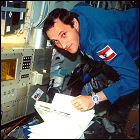 The Soviet Union launches its last space mission, Soyuz TM-13, carrying cosmonauts Alexander Volkov, Toktar Aubakirov and the first Austrian in space, Franz Viehböck, to space station Mir. After a week in space, Aubakirov and Viehböck return to Earth aboard Soyuz TM-12 with incumbent station crewmember Anatoly Artsebarksky, while Volkov stays for 175 days (alongside Krikalev, who will have been in space for 10 months by the time he returns to Earth in 1992). During Volkov and Krikalev’s stay aboard Mir, the Soviet Union collapses; they instead return to Earth as Russian citizens.
The Soviet Union launches its last space mission, Soyuz TM-13, carrying cosmonauts Alexander Volkov, Toktar Aubakirov and the first Austrian in space, Franz Viehböck, to space station Mir. After a week in space, Aubakirov and Viehböck return to Earth aboard Soyuz TM-12 with incumbent station crewmember Anatoly Artsebarksky, while Volkov stays for 175 days (alongside Krikalev, who will have been in space for 10 months by the time he returns to Earth in 1992). During Volkov and Krikalev’s stay aboard Mir, the Soviet Union collapses; they instead return to Earth as Russian citizens.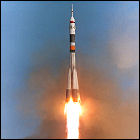 Soyuz TM-14 lifts off from the Baikonur Cosmodrome in Kazakhstan, the first space mission from post-Soviet Russia. It carries cosmonauts Alexander Viktorenko, Alexander Kaleri, and Klaus-Dietrich Flade to space station Mir. Viktorenko and Kaleri remain aboard Mir for 145 days, while Flade returns to Earth with the previous station crew aboard Soyuz TM-13. When TM-14 returns to Earth in August 1992, Viktorenko and Kaleri suffer an unusual landing, with their descent module rolling to an upside-down position, trapping the cosmonauts inside until rescue crews arrive.
Soyuz TM-14 lifts off from the Baikonur Cosmodrome in Kazakhstan, the first space mission from post-Soviet Russia. It carries cosmonauts Alexander Viktorenko, Alexander Kaleri, and Klaus-Dietrich Flade to space station Mir. Viktorenko and Kaleri remain aboard Mir for 145 days, while Flade returns to Earth with the previous station crew aboard Soyuz TM-13. When TM-14 returns to Earth in August 1992, Viktorenko and Kaleri suffer an unusual landing, with their descent module rolling to an upside-down position, trapping the cosmonauts inside until rescue crews arrive.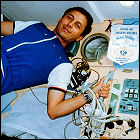 The Russian spacecraft Soyuz TM-15 lifts off from Kazakhstan, carrying cosmonauts Anatoly Solovyev and Sergei Avdeyev, along with French spationaut Michel Tognini, to space station Mir. Tognini remains aboard Mir for two weeks, returning with the Soyuz TM-14 crew, while Solovyev and Avdeyev are aboard for the long haul, manning Mir for 188 days before returning to Earth early in 1993.
The Russian spacecraft Soyuz TM-15 lifts off from Kazakhstan, carrying cosmonauts Anatoly Solovyev and Sergei Avdeyev, along with French spationaut Michel Tognini, to space station Mir. Tognini remains aboard Mir for two weeks, returning with the Soyuz TM-14 crew, while Solovyev and Avdeyev are aboard for the long haul, manning Mir for 188 days before returning to Earth early in 1993. Cosmonauts Gennadi Manakov and Alexander Poleshchuk lift off aboard Soyuz TM-16, on a course for Russian space station Mir. In preparation for the upcoming joint international missions that will see American space shuttles docking with Mir, Soyuz TM-16 carries a new type of docking mechanism designed to test the docking port that will be used by visiting shuttles. Manakov and Poleshchuk remain aboard Mir for 179 days, returning to Earth in July 1993 with French spationaut Jean-Pierre Haigneré.
Cosmonauts Gennadi Manakov and Alexander Poleshchuk lift off aboard Soyuz TM-16, on a course for Russian space station Mir. In preparation for the upcoming joint international missions that will see American space shuttles docking with Mir, Soyuz TM-16 carries a new type of docking mechanism designed to test the docking port that will be used by visiting shuttles. Manakov and Poleshchuk remain aboard Mir for 179 days, returning to Earth in July 1993 with French spationaut Jean-Pierre Haigneré.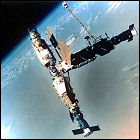 The Russian spacecraft Soyuz TM-17 lifts off from Kazakhstan, bound for space station Mir. Cosmonauts Vasili Tsibliyev, Aleksandr Serebrov replace the incumbent station crew, staying aboard Mir for 196 days, while Jean-Pierre Haigneré returns to Earth with the previous Mir crew aboard Soyuz TM-16 after a three-week stay. When the crew leaves Mir in January 1994, their departure is anything but routine, as Tsibliyev is unable to prevent a collision between Mir and the departing Soyuz.
The Russian spacecraft Soyuz TM-17 lifts off from Kazakhstan, bound for space station Mir. Cosmonauts Vasili Tsibliyev, Aleksandr Serebrov replace the incumbent station crew, staying aboard Mir for 196 days, while Jean-Pierre Haigneré returns to Earth with the previous Mir crew aboard Soyuz TM-16 after a three-week stay. When the crew leaves Mir in January 1994, their departure is anything but routine, as Tsibliyev is unable to prevent a collision between Mir and the departing Soyuz.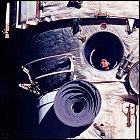 Russian spacecraft Soyuz TM-18 lifts off from Baikonur Cosmodrome in Kazakhstan, on a mission to the Russian space station Mir. Aboard the Soyuz are cosmonauts Viktor Afanasyev, Yuri Usachov, and Dr. Valeri Polyakov, a medical doctor who will study the effects of long-duration spaceflight on the crew (including himself). Following a scary close call with the previous crew’s wayward Soyuz, the TM-18 crew settles in for a 182-day stay, with Afanasyev and Usachov returning to Earth; Polyakov remains aboard Mir, where he will eventually set the human space endurance record with a 420-day stay in orbit.
Russian spacecraft Soyuz TM-18 lifts off from Baikonur Cosmodrome in Kazakhstan, on a mission to the Russian space station Mir. Aboard the Soyuz are cosmonauts Viktor Afanasyev, Yuri Usachov, and Dr. Valeri Polyakov, a medical doctor who will study the effects of long-duration spaceflight on the crew (including himself). Following a scary close call with the previous crew’s wayward Soyuz, the TM-18 crew settles in for a 182-day stay, with Afanasyev and Usachov returning to Earth; Polyakov remains aboard Mir, where he will eventually set the human space endurance record with a 420-day stay in orbit. Soyuz TM-19 lifts off from Kazakhstan, on a mission to the Russian space station Mir with cosmonauts Yuri Malenchenko and Talgat Musabayev aboard. Over the course of their 125-day stay, the crew joins Dr. Valery Polyakov aboard Mir, in the middle of his record-shattering 437-day stay in space. Malenchenko and Musabayev conduct 11 hours worth of spacewalks to repair Mir’s exterior insulation and other minor maintenance, and returns home in November 1994 with German astronaut Ulf Merbold.
Soyuz TM-19 lifts off from Kazakhstan, on a mission to the Russian space station Mir with cosmonauts Yuri Malenchenko and Talgat Musabayev aboard. Over the course of their 125-day stay, the crew joins Dr. Valery Polyakov aboard Mir, in the middle of his record-shattering 437-day stay in space. Malenchenko and Musabayev conduct 11 hours worth of spacewalks to repair Mir’s exterior insulation and other minor maintenance, and returns home in November 1994 with German astronaut Ulf Merbold.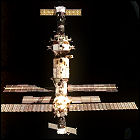 Russia launches the Soyuz TM-20 mission to space station Mir, carrying cosmonauts Alexander Viktorenko and Yelena Kondakova, and German astronaut Ulf Merbold, who will remain for only a month to conduct experiments in orbit. A glitch in the automated docking system forces Viktorenko to assume manual control for the docking with Mir, a problem which will plague future Mir crews. Viktorenko and Kondakova remain aboard Mir for 169 days, returning to Earth in March 1995 with the new space endurance world record holder, Dr. Valery Polyakov, who has spent 437 days in orbit.
Russia launches the Soyuz TM-20 mission to space station Mir, carrying cosmonauts Alexander Viktorenko and Yelena Kondakova, and German astronaut Ulf Merbold, who will remain for only a month to conduct experiments in orbit. A glitch in the automated docking system forces Viktorenko to assume manual control for the docking with Mir, a problem which will plague future Mir crews. Viktorenko and Kondakova remain aboard Mir for 169 days, returning to Earth in March 1995 with the new space endurance world record holder, Dr. Valery Polyakov, who has spent 437 days in orbit.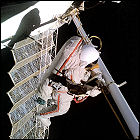 An American astronaut lifts off aboard a Russian Soyuz spacecraft for the first time ever with the launch of Soyuz TM-21, a mission to the Mir space station. Cosmonauts Vladimir Dezhurov and Gennady Strekalov are joined by astronaut Norman Thagard aboard Mir, where they remain for 115 days. During that time, they witness the arrival of the Spektr module, a new addition to the station, and they ultimately return to Earth aboard space shuttle Atlantis in July 1995; Soyuz TM-21 remains at the station, where a future Mir crew uses it to return to Earth. During the Atlantis mission, a new record is set for the number of humans in space, as the station and shuttle crews add up to 13 people in orbit at once.
An American astronaut lifts off aboard a Russian Soyuz spacecraft for the first time ever with the launch of Soyuz TM-21, a mission to the Mir space station. Cosmonauts Vladimir Dezhurov and Gennady Strekalov are joined by astronaut Norman Thagard aboard Mir, where they remain for 115 days. During that time, they witness the arrival of the Spektr module, a new addition to the station, and they ultimately return to Earth aboard space shuttle Atlantis in July 1995; Soyuz TM-21 remains at the station, where a future Mir crew uses it to return to Earth. During the Atlantis mission, a new record is set for the number of humans in space, as the station and shuttle crews add up to 13 people in orbit at once.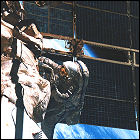 Russia launches the Soyuz TM-22 mission to space station Mir, carrying cosmonauts Yuri Gidzenko and Sergei Avdeyev from Russia, and Thomas Reiter from Germany. The three space travelers settle in for a 179-day stay aboard Mir, from which they will return early in 1996.
Russia launches the Soyuz TM-22 mission to space station Mir, carrying cosmonauts Yuri Gidzenko and Sergei Avdeyev from Russia, and Thomas Reiter from Germany. The three space travelers settle in for a 179-day stay aboard Mir, from which they will return early in 1996.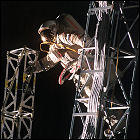 Russia launches the Soyuz TM-23 mission to the Mir space station. The crew, cosmonauts Yuri Onufrienko and Yury Usachov, remain aboard Mir for 193 days, returning to Earth in September 1996 with French spationaut Claudie André-Deshays.
Russia launches the Soyuz TM-23 mission to the Mir space station. The crew, cosmonauts Yuri Onufrienko and Yury Usachov, remain aboard Mir for 193 days, returning to Earth in September 1996 with French spationaut Claudie André-Deshays. Soyuz TM-24 is launched from Russia, on a mission to dock with the Mir space station. Aboard are cosmonauts Valery Korzun and Aleksandr Kaleri, who stay aboard Mir for 196 days, and visiting French spationaut Claudie André-Deshays, the first French woman in space, who stays aboard Mir for 16 days before returning to Earth with the station’s previous crew aboard Soyuz TM-23. Korzun and Kaleri will return to Earth in March 1997.
Soyuz TM-24 is launched from Russia, on a mission to dock with the Mir space station. Aboard are cosmonauts Valery Korzun and Aleksandr Kaleri, who stay aboard Mir for 196 days, and visiting French spationaut Claudie André-Deshays, the first French woman in space, who stays aboard Mir for 16 days before returning to Earth with the station’s previous crew aboard Soyuz TM-23. Korzun and Kaleri will return to Earth in March 1997. Russian cosmonauts Vasili Tsibliyev and Aleksandr Lazutkin lift off aboard Soyuz TM-25 for an eventful mission aboard Russian space station Mir. Tagging along is German space traveler Reinhold Ewald, who will remain in space for 19 days before returning to Earth with Mir’s previous crew aboard Soyuz TM-24; Tsibliyev and Lazutkin will later be joined by American shuttle astronaut Jerry Linenger. Their 184-day stay is marred by numerous emergencies aboard the station, ranging from a fire in the station’s cramped quarters to a collision with an unmanned Progress cargo spacecraft, which Russian ground controllers are initially eager to keep quiet from the rest of the world.
Russian cosmonauts Vasili Tsibliyev and Aleksandr Lazutkin lift off aboard Soyuz TM-25 for an eventful mission aboard Russian space station Mir. Tagging along is German space traveler Reinhold Ewald, who will remain in space for 19 days before returning to Earth with Mir’s previous crew aboard Soyuz TM-24; Tsibliyev and Lazutkin will later be joined by American shuttle astronaut Jerry Linenger. Their 184-day stay is marred by numerous emergencies aboard the station, ranging from a fire in the station’s cramped quarters to a collision with an unmanned Progress cargo spacecraft, which Russian ground controllers are initially eager to keep quiet from the rest of the world. Russia launches Soyuz TM-26 on a mission to the Mir space station, which suffered numerous major malfunctions and damage during its previous crew’s stay. Aboard the Soyuz are specially selected cosmonauts Anatoly Solovyev and Pavel Vinogradov, who have trained on the ground to inspect and repair the damage to the station, though they are unable to find the hull damage to the now-abandoned Spektr module which threatened to cause total decompression of the station. They do manage to restore most of Mir’s solar power generating capability during their 197-day stay, returning to Earth in February 1998 with French spationaut Léopold Eyharts.
Russia launches Soyuz TM-26 on a mission to the Mir space station, which suffered numerous major malfunctions and damage during its previous crew’s stay. Aboard the Soyuz are specially selected cosmonauts Anatoly Solovyev and Pavel Vinogradov, who have trained on the ground to inspect and repair the damage to the station, though they are unable to find the hull damage to the now-abandoned Spektr module which threatened to cause total decompression of the station. They do manage to restore most of Mir’s solar power generating capability during their 197-day stay, returning to Earth in February 1998 with French spationaut Léopold Eyharts.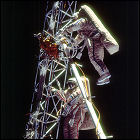 Russia launches the Soyuz TM-27 spacecraft on a mission to the Mir space station. Aboard are cosmonauts Talgat Musabayev and Nikolai Budarin; French spationaut Léopold Eyharts joins them for a 20-day before he returns to Earth with Mir’s previous crew. Musabayev and Budarin remain in orbit on Mir for 207 days, returning to Earth in August 1998 with cosmonaut Yuri Baturin. During their stay, further repairs were conducted to Mir’s solar power panels, which were damaged in a 1997 collision with a Progress unmanned cargo vehicle.
Russia launches the Soyuz TM-27 spacecraft on a mission to the Mir space station. Aboard are cosmonauts Talgat Musabayev and Nikolai Budarin; French spationaut Léopold Eyharts joins them for a 20-day before he returns to Earth with Mir’s previous crew. Musabayev and Budarin remain in orbit on Mir for 207 days, returning to Earth in August 1998 with cosmonaut Yuri Baturin. During their stay, further repairs were conducted to Mir’s solar power panels, which were damaged in a 1997 collision with a Progress unmanned cargo vehicle. Russia launches Soyuz TM-28 on a mission to the Mir space station, with cosmonauts Gennady Padalka, Sergei Avdeyev and Yuri Baturin aboard. Padalka spends 198 days aboard Mir, conducting further repairs to the station damaged by a 1997 collision with a Progress cargo vehicle, while former politician Baturin remains aboard for 11 days before returning to Earth aboard Soyuz TM-27 with Mir’s previous crew. Avdeyev is aboard Mir for the long haul, spending just over a year in space and not returning to Earth until August 1999.
Russia launches Soyuz TM-28 on a mission to the Mir space station, with cosmonauts Gennady Padalka, Sergei Avdeyev and Yuri Baturin aboard. Padalka spends 198 days aboard Mir, conducting further repairs to the station damaged by a 1997 collision with a Progress cargo vehicle, while former politician Baturin remains aboard for 11 days before returning to Earth aboard Soyuz TM-27 with Mir’s previous crew. Avdeyev is aboard Mir for the long haul, spending just over a year in space and not returning to Earth until August 1999.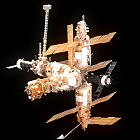 Russia launches Soyuz TM-29 to the Mir space station, carrying an international crew. Cosmonaut Viktor Afanasyev, French spationaut Jean-Pierre Haigneré, and Slovakian cosmonaut Ivan Bella are aboard. Afanasyev and Haigneré take up residence aboard Mir for 188 days, while Bella returns to Earth with Mir’s previous crew aboard Soyuz TM-28 after one week. When Afanasyev and Haigneré return to Earth in August 1999, they bring home cosmonaut Sergei Avdeyev, who by that point has served a full year in orbit aboard Mir. This is the last flight to Mir sponsored by the Russian government, which is now throwing its weight behind the International Space Station, and Mir is left unmanned when Soyuz TM-29 returns to Earth.
Russia launches Soyuz TM-29 to the Mir space station, carrying an international crew. Cosmonaut Viktor Afanasyev, French spationaut Jean-Pierre Haigneré, and Slovakian cosmonaut Ivan Bella are aboard. Afanasyev and Haigneré take up residence aboard Mir for 188 days, while Bella returns to Earth with Mir’s previous crew aboard Soyuz TM-28 after one week. When Afanasyev and Haigneré return to Earth in August 1999, they bring home cosmonaut Sergei Avdeyev, who by that point has served a full year in orbit aboard Mir. This is the last flight to Mir sponsored by the Russian government, which is now throwing its weight behind the International Space Station, and Mir is left unmanned when Soyuz TM-29 returns to Earth.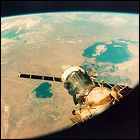 With help from the Russian space program, private corporation MirCorp launches Soyuz TM-30, the final spacecraft to visit the aging Mir space station. Sergei Zalyotin and veteran cosmonaut Aleksandr Kaleri become Mir’s first inhabitants in over eight months, and their mission is to begin refurbishing and repairing the 14-year-old station for what is hoped to be a series of commercial launches, including space tourism and even possibly a reality TV show set aboard Mir. What the two cosmonauts find, however, is that more work will be required than MirCorp can provide; after 72 days, the crew of Soyuz TM-30 returns to Earth, the money having run out before another crew can be sent. Mir will tumble out of its orbit and re-enter Earth’s atmosphere in 2001.
With help from the Russian space program, private corporation MirCorp launches Soyuz TM-30, the final spacecraft to visit the aging Mir space station. Sergei Zalyotin and veteran cosmonaut Aleksandr Kaleri become Mir’s first inhabitants in over eight months, and their mission is to begin refurbishing and repairing the 14-year-old station for what is hoped to be a series of commercial launches, including space tourism and even possibly a reality TV show set aboard Mir. What the two cosmonauts find, however, is that more work will be required than MirCorp can provide; after 72 days, the crew of Soyuz TM-30 returns to Earth, the money having run out before another crew can be sent. Mir will tumble out of its orbit and re-enter Earth’s atmosphere in 2001.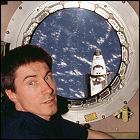 The crew of Soyuz TM-31 spends Halloween in orbit, lifting off from Russia’s Baikonur Cosmodrome on the first long-duration stay aboard the International Space Station. Cosmonauts Yuri Gidzenko and Sergei Krikalev and American astronaut William Shepherd are the first crew to take up residence on the ISS, staying aboard for 136 days. During that stay, they will be visited by the crews of three space shuttles (Endeavour, Atlantis and Discovery), all bringing new hardware modules to the station. This crew returns to Earth aboard Discovery, leaving the Soyuz TM-31 spacecraft as a return vehicle for the next ISS crew.
The crew of Soyuz TM-31 spends Halloween in orbit, lifting off from Russia’s Baikonur Cosmodrome on the first long-duration stay aboard the International Space Station. Cosmonauts Yuri Gidzenko and Sergei Krikalev and American astronaut William Shepherd are the first crew to take up residence on the ISS, staying aboard for 136 days. During that stay, they will be visited by the crews of three space shuttles (Endeavour, Atlantis and Discovery), all bringing new hardware modules to the station. This crew returns to Earth aboard Discovery, leaving the Soyuz TM-31 spacecraft as a return vehicle for the next ISS crew.